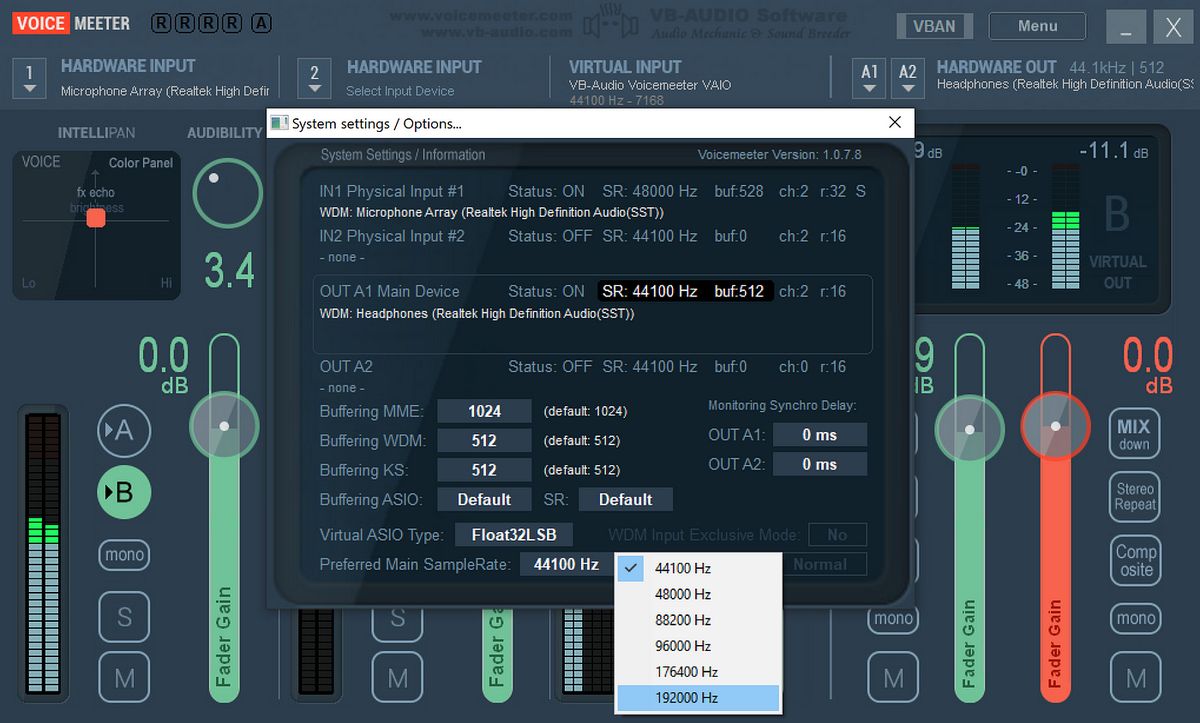Home>Production & Technology>Noise Cancellation>How To On Noise Cancellation In AirPods


Noise Cancellation
How To On Noise Cancellation In AirPods
Modified: January 22, 2024
Discover how to activate noise cancellation feature in your AirPods and enjoy a peaceful listening experience. Learn the step-by-step process for enabling noise cancellation on your AirPods.
(Many of the links in this article redirect to a specific reviewed product. Your purchase of these products through affiliate links helps to generate commission for AudioLover.com, at no extra cost. Learn more)
Table of Contents
Introduction
Welcome to the world of noise cancellation technology, where tranquility meets advanced audio experiences. Whether you’re a frequent traveler, a busy professional, or a music enthusiast, noise cancellation has become a game-changer in the realm of audio devices. And one device that has truly revolutionized the noise cancellation game is none other than the AirPods.
Designed by Apple, AirPods offer much more than just wireless connectivity and crisp audio quality. They also feature powerful noise cancellation capabilities that can transport you to a serene audio oasis, even in the noisiest of environments. With the ability to block out external noise, AirPods allow you to immerse yourself in your favorite music or simply enjoy the blissful silence.
In this article, we will delve into the intriguing world of noise cancellation technology and explore how it works in AirPods. We will guide you on how to activate noise cancellation, adjust its levels, and maximize its efficiency. So, let’s embark on this audio journey and unlock the secrets of noise cancellation in AirPods.
Understanding Noise Cancellation Technology
Noise cancellation technology is a remarkable innovation that allows you to enjoy your audio without the interference of external sounds. It works by using advanced algorithms and built-in microphones to analyze the ambient noises around you and produce an inverted sound wave that effectively cancels out those unwanted sounds.
There are two primary types of noise cancellation: passive and active. Passive noise cancellation relies on the physical design of the headphones or earbuds to block out external noise. This is achieved through materials that provide a tight seal around your ears, effectively reducing the amount of sound that reaches your ears.
On the other hand, active noise cancellation (ANC) takes noise cancellation to a whole new level. It actively generates sound waves that are 180 degrees out of phase with the ambient noise, thus canceling it out. This technology is particularly effective in environments with constant low-frequency noise, such as the hum of airplane engines or the rumble of a train.
The ANC mechanism in AirPods is powered by the H1 chip, an Apple-designed processor specifically built for wireless audio devices. This chip enables AirPods to constantly sample the sounds around you and generate corresponding anti-noise waves in real-time. The result is a notably quieter listening experience, allowing you to fully immerse yourself in the audio content of your choice.
It’s worth noting that while noise cancellation can effectively reduce background noise, it may not completely eliminate all sounds. Sudden and sharp noises, such as alarms or loud voices, may still be audible. Additionally, noise cancellation can vary in effectiveness depending on the quality of the headphones or earbuds and the accuracy of the algorithms used.
Now that we have a basic understanding of the technology behind noise cancellation, let’s explore how it functions in AirPods and how you can make the most of this feature.
How Noise Cancellation Works in AirPods
AirPods use a combination of advanced hardware and intelligent software to deliver impressive noise cancellation capabilities. The heart of this technology lies within the H1 chip, which plays a vital role in analyzing the surrounding sounds and producing the anti-noise waves that cancel them out.
The H1 chip consists of multiple microphones strategically placed in each AirPod, including an inward-facing microphone and an outward-facing microphone. These microphones work together to detect and analyze the environmental noises around you.
When you activate noise cancellation on your AirPods, the microphones capture the ambient sounds and send them to the H1 chip for processing. The chip then generates anti-noise waves that are precisely aligned with the incoming noise, effectively canceling it out and creating a quieter audio experience.
One of the key aspects of AirPods’ noise cancellation feature is its ability to adapt in real-time. The H1 chip continuously monitors the noise profile and adjusts the anti-noise waves accordingly. This dynamic adjustment ensures optimal noise cancellation performance, even in changing environments.
In addition to active noise cancellation, AirPods also employ a feature called Transparency mode. When activated, Transparency mode allows you to remain aware of your surroundings by using the microphones to amplify the external sounds. This is particularly useful in situations where you need to interact with others or stay alert to your surroundings while still enjoying your audio.
Overall, the combination of advanced microphones, the H1 chip, and intelligent algorithms enables AirPods to deliver impressive noise cancellation capabilities. Whether you’re on a busy city street, in a crowded airport, or simply seeking an escape from the daily noise, AirPods can provide you with a peaceful and immersive audio experience.
Activating Noise Cancellation on AirPods
Activating noise cancellation on your AirPods is a straightforward process. With just a few taps, you can immerse yourself in a world of isolated audio bliss.
- Start by ensuring that your AirPods are connected to your device, such as an iPhone or iPad.
- Open the Control Center on your device. On an iPhone, swipe down from the top right corner of the screen (for iPhone X and later) or swipe up from the bottom (for iPhone 8 and earlier). On an iPad, swipe down from the top right corner of the screen.
- In the Control Center, look for the volume slider.
- Tap on the volume slider to expand it and reveal additional audio controls.
- Within the expanded volume slider, you will find an icon that resembles an ear with sound waves or an AirPods symbol. Tap on this icon.
- A submenu will appear with three options: Off, Noise Cancellation, and Transparency. Tap on “Noise Cancellation” to activate the noise cancellation feature on your AirPods.
- Once activated, you will immediately notice a reduction in external noise, allowing you to focus on your audio or simply enjoy the serene silence.
It’s important to note that activating noise cancellation on AirPods requires the firmware to be up to date. Make sure your AirPods are running on the latest firmware by keeping them connected to your device and regularly checking for updates through the Settings app.
Remember, you can always access the Control Center to adjust or disable noise cancellation on your AirPods whenever you desire. This flexibility allows you to tailor your audio experience based on your surroundings and personal preferences.
Now that you know how to activate noise cancellation on your AirPods, let’s explore how to adjust the noise cancellation levels to further enhance your listening experience.
Adjusting Noise Cancellation Levels
While noise cancellation on AirPods is typically a one-size-fits-all solution, Apple has introduced a nifty feature that allows you to customize the intensity of the noise cancellation. This gives you greater control over your audio experience and lets you strike a balance between blocking out external noise and remaining aware of your surroundings.
To adjust the noise cancellation levels on your AirPods, follow these steps:
- Ensure that your AirPods are connected to your device and noise cancellation is activated.
- Open the Control Center on your device. On an iPhone or iPad, swipe down from the top right corner (for iPhone X and later) or swipe up from the bottom (for iPhone 8 and earlier).
- In the expanded volume slider, locate the “Noise Cancellation” option.
- Tap on the “Noise Cancellation” option to reveal the available levels: Off, Low, or High.
- Select the desired level by tapping on it.
By default, AirPods are set to the “High” level of noise cancellation. This level is ideal for blocking out the maximum amount of background noise, ensuring a tranquil audio experience. However, there may be situations where you need to stay more aware of your surroundings, such as when walking on a busy street or commuting on public transportation.
In such cases, you can switch to the “Low” level of noise cancellation. This level reduces the intensity of noise cancellation, allowing you to hear some ambient sounds while still enjoying the benefits of noise reduction. It’s a great option for situations where you need to strike a balance between immersing yourself in audio and maintaining awareness of your environment.
If you find that you don’t need noise cancellation at a certain time, you can always select the “Off” option. This disables noise cancellation entirely and allows you to listen to audio without any alterations to the ambient sounds.
Experiment with different noise cancellation levels to find the setting that suits your preferences and the surrounding environment best. Whether you prefer complete isolation or a bit of ambient awareness, AirPods offer the flexibility to customize your noise cancellation experience.
Now that you’re familiar with adjusting noise cancellation levels, let’s explore some tips for maximizing the efficiency of noise cancellation on your AirPods.
Tips for Maximizing Noise Cancellation Efficiency
To get the most out of the noise cancellation feature on your AirPods, consider these helpful tips and tricks:
- Ensure a proper fit: Properly fitting your AirPods is crucial for optimal noise cancellation. Make sure they create a tight seal in your ears to effectively block out external sounds. Adjust the positioning and try different ear tip sizes if necessary.
- Experiment with noise cancellation levels: As mentioned earlier, try different noise cancellation levels (low, high, or off) to find the setting that suits your preferences and the surrounding environment best.
- Minimize external noise sources: While noise cancellation is excellent at reducing background noise, it’s always beneficial to minimize the sources of external noise as much as possible. Find quieter environments or use soundproofing techniques when needed.
- Keep your AirPods charged: Noise cancellation performance can be compromised if your AirPods’ battery level is low. Keep them charged to ensure optimal performance and uninterrupted noise cancellation.
- Stay up to date: Keep your AirPods firmware updated to enjoy the latest noise cancellation improvements and bug fixes. Regularly check for updates through the Settings app on your device.
- Utilize Transparency mode: Apart from noise cancellation, AirPods also offer a Transparency mode that amplifies external sounds. This is useful when you need to stay aware of your surroundings while still enjoying your audio.
- Use the proper audio format: When streaming or playing audio, use high-quality formats like lossless or high-bitrate files. This can enhance the overall audio experience and improve noise cancellation performance.
- Take care of your AirPods: Keep your AirPods clean and free from debris, as this can affect their noise cancellation efficiency. Regularly wipe them down and clean the ear tips to ensure optimal performance.
By following these tips, you can maximize the efficiency of noise cancellation on your AirPods and enjoy an immersive and tranquil audio experience.
Next, let’s explore some common troubleshooting tips for any noise cancellation issues you may encounter.
Troubleshooting Noise Cancellation Issues
While AirPods provide excellent noise cancellation performance, you may occasionally encounter some issues. Here are some troubleshooting tips to help you address common noise cancellation problems:
- Check for a proper fit: Ensure that your AirPods are securely and comfortably seated in your ears. A good fit is crucial for effective noise cancellation.
- Clean your AirPods: Over time, debris and earwax can accumulate on the ear tips and affect noise cancellation. Clean your AirPods regularly by gently wiping them with a soft, lint-free cloth and, if needed, removing and rinsing the ear tips with water.
- Update firmware and software: Ensure that both your AirPods and the device you’re using are running on the latest firmware and software versions. Updates often include bug fixes and performance improvements.
- Reset your AirPods: If you’re experiencing persistent issues with noise cancellation, try resetting your AirPods. Open the Settings app on your device, go to “Bluetooth,” find your AirPods in the list of connected devices, and tap on the (i) icon. Then, select “Forget This Device” and follow the instructions to reset the AirPods.
- Reset network settings: In some cases, noise cancellation performance can be affected by network connectivity issues. Resetting your network settings can help resolve these problems. Go to the Settings app on your device, navigate to “General,” then “Reset,” and select “Reset Network Settings.”
- Try different noise cancellation levels: If you find that noise cancellation isn’t working as expected, try adjusting the noise cancellation level. Experiment with both the low and high levels to find the setting that provides the desired noise reduction.
- Contact Apple Support: If you have tried the above troubleshooting steps and are still experiencing issues with noise cancellation, reach out to Apple Support for further assistance. They can provide personalized guidance and troubleshooting specific to your AirPods.
Remember, noise cancellation performance can vary depending on the surrounding environment, audio content, and individual preferences. It’s important to have realistic expectations and understand that complete elimination of all external noise may not always be possible.
By following these troubleshooting tips and reaching out to support if needed, you can address and resolve noise cancellation issues, ensuring an optimal listening experience with your AirPods.
Now, let’s wrap up our exploration of noise cancellation in AirPods.
Conclusion
Noise cancellation technology has undoubtedly revolutionized the way we enjoy audio, and AirPods have taken this technology to new heights. With their powerful noise cancellation capabilities, these wireless earbuds offer an immersive and tranquil audio experience.
In this article, we explored the underlying technology of noise cancellation and how it works in AirPods. We learned about the H1 chip and its role in analyzing ambient sounds and producing anti-noise waves. We discovered how to activate noise cancellation on AirPods through the Control Center and adjust the intensity of noise cancellation to suit our preferences and surroundings.
We also shared some tips for maximizing the efficiency of noise cancellation, such as ensuring a proper fit, keeping your AirPods charged, and staying up to date with firmware updates. Additionally, we provided troubleshooting suggestions for common noise cancellation issues, such as checking for a proper fit, cleaning your AirPods, and updating firmware and software.
AirPods with noise cancellation truly elevate the audio experience, whether you’re commuting in a noisy city, working in a bustling office, or simply trying to enjoy your favorite music in peace. The ability to immerse yourself in audio or remain aware of your surroundings through Transparency mode offers a level of flexibility that enhances your overall listening experience.
So, whether you’re a frequent traveler seeking respite from airplane engines, an office worker looking to block out distracting noises, or a music lover wanting to indulge in pure sound, AirPods with noise cancellation can be your audio sanctuary.
Invest in a pair of AirPods and embrace the magic of noise cancellation technology. Immerse yourself in the music, find your zen in the silence, and enjoy audio like never before.
Experience the future of audio with AirPods and let noise cancellation transport you to a world of tranquility and sonic bliss.











